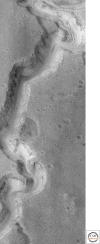An origin of life on Mars
- PMID: 20452949
- PMCID: PMC2845199
- DOI: 10.1101/cshperspect.a003509
An origin of life on Mars
Abstract
Evidence of past liquid water on the surface of Mars suggests that this world once had habitable conditions and leads to the question of life. If there was life on Mars, it would be interesting to determine if it represented a separate origin from life on Earth. To determine the biochemistry and genetics of life on Mars requires that we have access to an organism or the biological remains of one-possibly preserved in ancient permafrost. A way to determine if organic material found on Mars represents the remains of an alien biological system could be based on the observation that biological systems select certain organic molecules over others that are chemically similar (e.g., chirality in amino acids).
Figures




Similar articles
-
Planning Implications Related to Sterilization-Sensitive Science Investigations Associated with Mars Sample Return (MSR).Astrobiology. 2022 Jun;22(S1):S112-S164. doi: 10.1089/AST.2021.0113. Epub 2022 May 19. Astrobiology. 2022. PMID: 34904892
-
Why exobiology on Mars?Planet Space Sci. 1996 Nov;44(11):1435-40. doi: 10.1016/s0032-0633(96)00027-x. Planet Space Sci. 1996. PMID: 11541122 Review.
-
Could organic matter have been preserved on Mars for 3.5 billion years?Icarus. 1990 Mar;84(1):196-202. doi: 10.1016/0019-1035(90)90165-6. Icarus. 1990. PMID: 11538399
-
Resolving the History of Life on Earth by Seeking Life As We Know It on Mars.Astrobiology. 2022 Jul;22(7):880-888. doi: 10.1089/ast.2021.0043. Epub 2022 Apr 25. Astrobiology. 2022. PMID: 35467949 Free PMC article.
-
Origins of life: a comparison of theories and application to Mars.Orig Life Evol Biosph. 1996 Feb;26(1):61-73. doi: 10.1007/BF01808160. Orig Life Evol Biosph. 1996. PMID: 8920171 Review.
Cited by
-
Preservation of Biomarkers from Cyanobacteria Mixed with Mars-Like Regolith Under Simulated Martian Atmosphere and UV Flux.Orig Life Evol Biosph. 2016 Jun;46(2-3):289-310. doi: 10.1007/s11084-015-9467-9. Epub 2015 Nov 3. Orig Life Evol Biosph. 2016. PMID: 26530341
-
The Coevolution of Life and Environment on Mars: An Ecosystem Perspective on the Robotic Exploration of Biosignatures.Astrobiology. 2018 Jan;18(1):1-27. doi: 10.1089/ast.2017.1756. Epub 2017 Dec 18. Astrobiology. 2018. PMID: 29252008 Free PMC article.
-
Mineral Indicators of Geologically Recent Past Habitability on Mars.Life (Basel). 2023 Dec 15;13(12):2349. doi: 10.3390/life13122349. Life (Basel). 2023. PMID: 38137950 Free PMC article.
-
Chiral polymerization in open systems from chiral-selective reaction rates.Orig Life Evol Biosph. 2012 Aug;42(4):333-46. doi: 10.1007/s11084-012-9274-5. Epub 2012 May 19. Orig Life Evol Biosph. 2012. PMID: 22610131
-
Nucleic Acid Extraction and Sequencing from Low-Biomass Synthetic Mars Analog Soils for In Situ Life Detection.Astrobiology. 2019 Sep;19(9):1139-1152. doi: 10.1089/ast.2018.1929. Epub 2019 Jun 11. Astrobiology. 2019. PMID: 31204862 Free PMC article.
References
-
- Abramov O, Mojzsis SJ 2009. Microbial habitability of the terrestrial biosphere during the late heavy bombardment. Nature 459:419–422 - PubMed
-
- Acuña MH, Connerney JEP, Ness NF, Lin RP, Mitchell D, Carlson CW, McFadden J, Anderson KA, Reme H, Mazelle C, et al.1999. Global distribution of crustal magnetism discovered by the Mars Global Surveyor MAG/ER experiment. Science 284:790–793 - PubMed
-
- Allwood AC, Walter MR, Kamber BS, Burch IW 2006. Stromatolite reef from the early Archaean era of Australia. Nature 414:714–718 - PubMed
-
- Barlow N 1997. Mars: Impact craters. In Encyclopedia of planetary sciences (ed. Shirley JH, Fairbridge RW), pp. 196–202 Chapman and Hall, London, UK
-
- Boston PJ, Ivanov MV, McKay CP 1992. On the possibility of chemosynthetic ecosystems in subsurface habitats on Mars. Icarus 95:300–308 - PubMed
Publication types
MeSH terms
Substances
LinkOut - more resources
Full Text Sources
Miscellaneous
